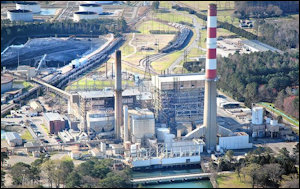
Yorktown Power Station. Photo credit: Daily Press
The day, April 15, is fast approaching when Dominion Virginia Power will be compelled by federal regulations to shut down two coal-fired generating units at the Yorktown Power Station, exposing the Virginia Peninsula to the risk of blackouts.
When the Yorktown units are shuttered, the utility will have enough electric power to supply the half million-person region from the outside most of the time. But during periods of peak demand, usually during the summer, an accident knocking one of those lines out of commission will put the region only one more incident away from uncontrolled, cascading blackouts that could spread to Norfolk, Richmond and beyond. Rather than incur any chance of disaster, PJM Interconnection, the organization that controls the transmission grid for a 12-state region that includes Virginia, would “shed load” — in other words, cut off electric power to some residents and businesses on the Peninsula.
Dominion’s proposed backup, the Surry-Skiffes transmission line, remains in a state of regulatory limbo while the U.S. Army Corps of Engineers negotiates ways to mitigate the line’s impact on a near-pristine stretch of the James River near Jamestown. Even if the Corps gave Dominion a permit tomorrow, it will take 18 months — and two summers — before the line can be built.
If I were a Peninsula business or resident, I’d be wondering, is it time to panic yet? I put the questions to Dominion: How frequent will the blackouts be and how bad will they be?
The answer: The threat is real but small in any given year, and a blackout, if it occurs, is likely to be limited in scope and duration. However, while the Peninsula might skate through the next year or two without a blackout, the situation is intolerable over the long run, Dominion warns. The Peninsula is the region most exposed to blackouts in the Dominion system and possibly the most vulnerable in the entire PJM transmission grid.
“This is a serious situation,” says Steve Chafin, Dominion director of transmission planning and strategic initiatives. When three things come together — (1) temperatures are running high, (2) the Yorktown 3 unit isn’t running, and (3) an accident knocks out a transmission line or sub-station — PJM likely will have to shed load.
Assuming normal weather conditions, the Peninsula will experience between 50 and 80 “high risk” days, Chafin says. Peak consumption is likely to occur in the summer, when temperatures are highest, although a few days may occur in the winter when temperatures are extremely low.
Although the company is closing two coal-fired units, the Environmental Protection Agency will allow it to run Yorktown 3, a oil-fired unit, 8% of the time, or up to 29 days. Using Yorktown 3 as a backup will reduce the number of vulnerable days to between 20 to 50.
Transmission lines to the Peninsula have been knocked out by accidents, component malfunctions or other causes six times in the past 10 years — an average of once every 20 months. (There have been two incidents in the past 10 years in which two simultaneous outages occurred.)
To reduce the odds of such mishaps shutting down a transmission line, the utility has been increasing its patrols of electric lines, boosting sub-station inspections and running infrared scanner. “This is not a normal mode of operation,” says Chafin. “We don’t patrol our transmission lines this frequently.”
If a once-every-twenty-months line outage occurs during one of the 20 to 50 at-risk days of heavy consumption when Yorktown 3 isn’t running, the electric grid will be at risk of an uncontrolled, cascading blackout. PJM, working in coordination with Dominion, will decide whether or not to shed load.
Should it become necessary to cut electricity consumption, the goal will be to disrupt as few people as possible and spare critical infrastructure such as hospitals and water treatment plants. PJM and Dominion would continuously run contingency models to determine the best course of action.
“Our goal is to avoid the need for temporary service interruptions, but should it become necessary, we will do all we can to limit the number of customers and duration,” Chafin says. “In the end, these are temporary measures to protect the larger grid from widespread, uncontrolled outages.”
Should blackouts occur, they likely would not last all day or affect the entire Peninsula. The company would close no more circuits than needed to drop electricity consumption to within a safe range. Giving a hypothetical example, Chafin says, “We might do two or three blocks of circuits of a few thousand customers for an hour or two.”
Dominion also would ask Peninsula customers to voluntarily conserve electricity. “The more the conservation, the shorter the duration and the fewer people affected,” he says.
With a little luck the Peninsula might escape unscathed, Chafin says. “We’re running drills to make sure we’re ready. We think we can get through the summer without any rotating blackouts.”


